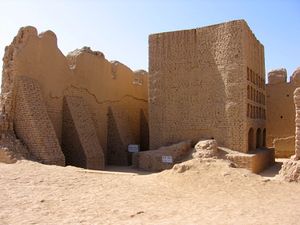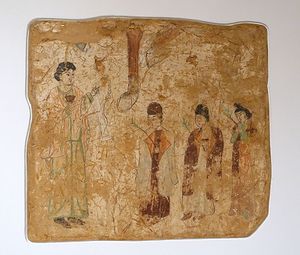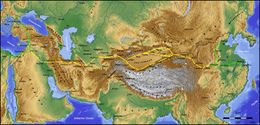گاوتشانگ
قۇچۇ 高昌 | |
 | |
| المكان | Xinjiang, الصين |
|---|---|
| الإحداثيات | 42°51′10″N 89°31′45″E / 42.85278°N 89.52917°E |
| النوع | مستوطنة |
| ملاحظات حول الموقع | |
| الحالة | In ruins |
Gaochang[1] (Chinese: 高昌; pinyin: Gāochāng; Old Uyghur: قۇچۇ, Qocho), also called Karakhoja, Qara-hoja, Kara-Khoja, or Karahoja (قاراغوجا in Uyghur), is the site of a ruined, ancient oasis city on the northern rim of the inhospitable Taklamakan Desert in present-day Xinjiang, China. The site is also known in published reports as Chotscho, Khocho, Qocho, or Qočo. During the Yuan and Ming dynasties, Gaochang was referred to as "Halahezhuo" (哈拉和卓) (Qara-khoja) and Huozhou.
The ruins are located 30 km southeast of modern Turpan.[2] The archaeological remains are just outside the modern town of Gaochang, at a place called Idykut-schari or Idikutschari by local residents. (see the work of Albert Grünwedel in the external links below). Artistic depictions of the city have been published by Albert von Le Coq. Gaochang is considered in some sources to have been a "Chinese colony",[3][4] that is, it was located in a region otherwise occupied at the time by West Eurasian peoples.
A busy trading center, it was a stopping point for merchant traders traveling on the Silk Road. It was destroyed in wars during the 14th century, and old palace ruins and inside and outside cities can still be seen today.
Near Gaochang is another major archeological site: the Astana tombs.
التاريخ
مملكة جوشي والحكم المبكر للهان الصينيين
The earliest people known to have lived in the area were the Gushi (or Jushi). The region around Turfan was described during the Han dynasty (206 BCE – 220 CE) as being occupied by the Jūshī, while control over the region swayed between the Han-Chinese and the Xiongnu.

حكم تانگ
Uyghur Kingdom of Qocho
The Gaochang area was conquered by the Mongols of the Chagatai Khanate (not part of Yuan Dynasty) from 1275 to 1318 by as many as 120,000 troops.
البوذية
Buddhism spread to China from India along the northern branch of the Silk Road predominantly in the 4th and 5th centuries as the Liang rulers were Buddhists.[5] The building of Buddhist grottos probably began during this period. There are clusters close to Gaochang, the largest being the Bezeklik grottos.[2]
Gaochang ruling families
Rulers of the Kan Family
| Family names and given name | Durations of reigns | Era names and their according durations | |
|---|---|---|---|
| Kàn Bózhōu | 460-477 | Did not exist | |
| Kàn Yìchéng | 477-478 | Did not exist | |
| Kàn Shǒugūi | 478-488? or 478-491? |
Did not exist | |
Rulers of the Zhang Family
| Family names and given name | Durations of reigns | Era names and their according durations | |
|---|---|---|---|
| Zhāng Mèngmíng | 488?-496 or 491?-496 |
Did not exist | |
Rulers of the Ma Family
| Family names and given name | Durations of reigns | Era names and their according durations | |
|---|---|---|---|
| Mǎ Rú | 496-501 | Did not exist | |
Rulers of the Qu Family
| Family names and given name | Durations of reigns | Era names and their according durations | |
|---|---|---|---|
| Qú Jiā | 501-525 | ||
| Qú Guāng | 525-530 | Ganlu (甘露 Gānlù) 525-530 | |
| Qú Jiān | 530-548 | Zhanghe (章和 Zhānghé) 531-548 | |
| Qú Xuánxǐ | 549-550 | Yongping (永平 Yǒngpíng) 549-550 | |
| unnamed son of Qu Xuanxi | 551-554 | Heping (和平 Hépíng) 551-554 | |
| Qú Bǎomào | 555-560 | Jianchang (建昌 Jiànchāng) 555-560 | |
| Qú Qiángù | 560-601 | Yanchang (延昌 Yánchāng) 561-601 | |
| Qú Bóyǎ[6] | 601-613 619-623 |
Yanhe (延和 Yánhé) 602-613 Zhongguang (重光 Zhòngguāng) 620-623 | |
| unnamed usurper | 613-619 | Yihe (Yìhé 義和) 614-619 | |
| Qú Wéntài | 623-640 | Yanshou (延壽 Yánshòu) 624-640 | |
| Qú Zhìshèng | 640 | did not exist | |
Gallery
انظر أيضاً
المراجع
Citations
- ^ Charles Eliot (4 January 2016). Hinduism and Buddhism: An Historical Sketch. Sai ePublications & Sai Shop. pp. 1075–. GGKEY:4TQAY7XLN48.
- ^ أ ب "The Silk Road". ess.uci.edu. Archived from the original on 2016-03-15. Retrieved 2007-09-21.
{{cite web}}: Unknown parameter|deadurl=ignored (|url-status=suggested) (help) - ^ خطأ استشهاد: وسم
<ref>غير صحيح؛ لا نص تم توفيره للمراجع المسماةlouis - ^ Jacques Gernet (1996). A history of Chinese civilization. Cambridge University Press. p. 253. ISBN 0-521-49781-7. Retrieved 17 May 2011.
- ^ 北凉且渠安周造寺碑 Archived 2011-08-20 at the Wayback Machine
- ^ Victor Cunrui Xiong (1 February 2012). Emperor Yang of the Sui Dynasty: His Life, Times, and Legacy. SUNY Press. pp. 206–. ISBN 978-0-7914-8268-1.
المصادر
- Bericht über archäologische Arbeiten in Idikutschari und Umgebung im Winter 1902-1903 : vol.1
- Chen, Huaiyu (2014), "Religion and Society on the Silk Road: The Inscriptional Evidence from Turfan", in Swartz, Wendy, Early Medieval China: A Sourcebook, New York: Columbia University Press, ISBN 978-0-231-15987-6, https://books.google.com/books?id=ffEYBQAAQBAJ&pg=PA176.
وصلات خارجية
- Along the ancient silk routes: Central Asian art from the West Berlin State Museums, an exhibition catalog from The Metropolitan Museum of Art (fully available online as PDF), which contains material from Gaochang
- Online version of Albert Grünwedel's initial work in the area
- Online version of Grünwedel's further work in the area
- Online version of Le Coq's work on monuments of Gaochang
- Pages using gadget WikiMiniAtlas
- CS1 errors: unsupported parameter
- Coordinates on Wikidata
- Articles containing Chinese-language text
- Articles with hatnote templates targeting a nonexistent page
- تورفان
- أماكن مأهولة سابقاً في شينجيانگ
- أماكن مأهولة على طريق الحرير
- بلدان سابقة في التاريخ الصيني
- واحات الصين
- مدن مدمرة
- مواقع تاريخية وثقافية وطنية رئيسية في شينجيانگ
- ملكيات سابقة في شرق آسيا






